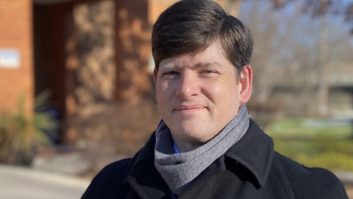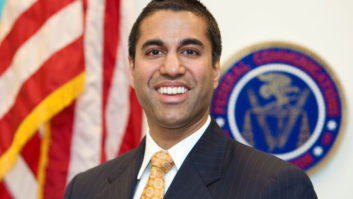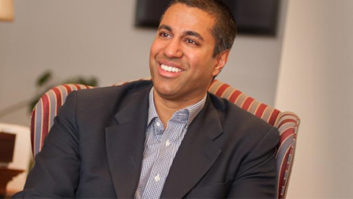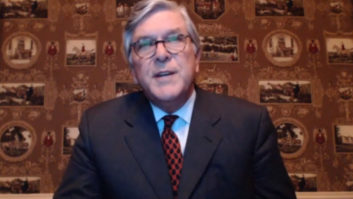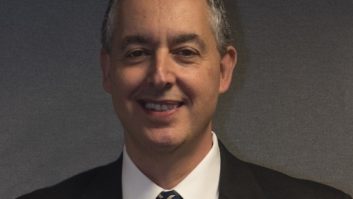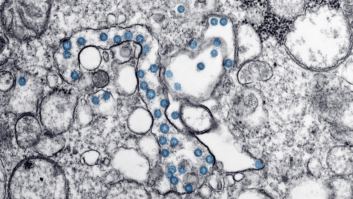Radio World sat down with Federal Communications Commission Chairman Ajit Pai at FCC headquarters this month; it was his first interview with a radio broadcast trade publication since becoming chairman. He met with Editor in Chief Paul McLane and Contributing Editor Emily Reigart. The conversation touched on the main studio rule, cross-ownership, the future of digital radio, his regulatory philosophy and other topics. Questions and answers have been edited for brevity.

Photos by Bob Kovacs
Radio World: We’ve all been struck in the industry about your personal warmth for radio. Talk a little bit about why you have such an obvious connection with this medium.
Pai: Part of it to me is personal. I grew up in a small town in rural Kansas, and some of my fondest memories involve listening to radio, listening to KLKC, my local station, cover our high school team in 1987, when we were in the state basketball championship. My mom wouldn’t let me go, so I was in my bedroom listening to my transistor radio, listening to KLKC cover the game.
Part of it is also in my current role here at the FCC. I’ve had a chance to visit with radio broadcasters around the country. I just love some of those visits.
To KDKA. That’s history in the making — the first broadcast of the presidential race, calling the results of Harding’s victory. Visiting station KZPA in Fort Yukon, Alaska, where literally I just popped in and talked to the program director unannounced. Didn’t ask for his public file! But it’s just great to be able to visit with him.
Wherever I go, I always try to visit some radio broadcasters if I can, because I think what they do is so unique, it’s so local, it’s so social, it’s increasingly mobile too. People use the radios in their cars or apps on smartphones. I just think it’s such a vital medium.
It speaks volumes, I think, that 93 percent of Americans above the age of 12 still listen to the radio regularly, about 12 hours a week, I think, is the figure. I’m glad to see there are many Americans like me who love it.
RW: How do you interact personally with radio content every day? You and your family.
Pai: It’s mostly during drive-time for me. I have a combination of podcasts and an app that I use to listen to my hometown station. I use TuneIn to listen to KLKC, 1540. My wife, she’s a doctor over at George Washington University, and during her day she doesn’t have time to keep up with the news, so she usually listens to 88.5 NPR [WAMU] on the way in, and then either NPR or C-SPAN Radio on the way back.
Also, we have an Amazon Echo at home, so one of the great things about that is you can tell it, “Alexa, play 88.5,” and you can listen while you’re making dinner to whatever station you want. I certainly rely on that a lot. It’s pretty handy.
RW: Your kids probably like talking to it.
Pai: Yeah. For better or worse they’ve learned how to use it, so now their current favorite song is “We Are Family,” Sister Sledge. I used to like that song as well, but now it’s on a continuous loop, so I’ve just gotten sick of it.

Chairman Ajit Pai discussed regulatory issues with Radio World in this March 10 interview. His Acting Media Advisor Alison Nemeth is at right rear.
RW: Let me ask you to talk about your understanding of the purpose of the FCC. The big picture. Why does the commission exist now, and what do you think it should be doing?
Pai: As you know, it originated because there was a need for the FCC to figure out problems of interference. In the 21st century, I think we have a pretty broad scope. The big picture takeaway, for me, is to enable as many Americans as possible to benefit from all of the services that the communications sector seeks to provide: radio, TV, satellite, cable, telephone, internet, you name it. Our role is to make sure that as many Americans who want access to those services are able to get them in a competitive marketplace.
There are a number of principles that I try to apply to make that happen. The FCC should strive to promote competition and innovation and investment in this industry. We should make sure that we consistently defend consumer welfare and the public interest. We should always try to promote public safety, especially in cases of emergencies. It’s essentially vital for people to have access to that information.
The bottom line is that we want to be able to help the private sector deliver these services to many Americans, while respecting the principles of economics and physics and law as best we can.
RW: What kind of a philosophy or temperament can we expect from you?
Pai: Past is prologue. I’ve served as a commissioner for about four and a half years; you can get a pretty good sense of where I’m going to be heading from where I’ve been — a very active participant in the commission’s policymaking; somebody who is going to be very forward-thinking in terms of how to modernize our regulatory approach, to make sure that our rules match the realities of the modern marketplace; somebody who is going to be willing to have an open door and an open mind to anybody with a good idea.
We certainly don’t claim to have a monopoly on wisdom. Some of the ideas we’ve championed have come to us from the outside. We’re more than willing to share the credit with everybody if it gets a good result for the American people.

RW: You’ve been vocal about the desirability of turning on FM receiver chips, although you don’t support a mandate. Will you use the bully pulpit of this office to put some friendly pressure on the people who can put this in action?
Pai: I will, and I have, actually. My very first speech as chairman, before the North American Broadcasters Association, I pointed out that both as a chairman and as a consumer, I would appreciate the functionality that FM chip activation in smartphones would provide.
It’s a way for consumers to save battery life, to consume data exempt from any data limits they might have. Also, if you think about it, given the fact that 93 percent of Americans already rely on radio, if you enable this device that virtually every American seems to have now in their pocket to [receive] FM signals, that would be a really powerful proposition that I think a lot of people would take advantage of.
In a lot of cases, we are seeing consumer demand incentivizing carriers to activate that functionality. I think something like 44 percent of smartphones in the Unites States now include it. Obviously, through advocacy we’d like to get that number up. I met recently with my counterparts in Mexico, and I observed that 80 percent of the smartphones sold in Mexico have this functionality activated. My counterparts told me that’s something they hear that consumers really enjoy.
As I pointed out in my speech, I don’t think the FCC has the legal authority to issue a mandate; but hopefully working together, this is going to be something that both sides of the coin, so to speak, can come to an agreement on for the benefit of consumers.
RW: Have you had any conversations with Apple about this? They so far have been reluctant.
Pai: I haven’t yet had a chance to do that, but hopefully we’ll have a chance to keep spreading this message, which I think is a good one for consumers and companies alike to hear.
RW: Let’s talk about cross-ownership. Do you think that we’ll see that anytime soon? Will you be able to abolish those rules?
Pai: I can’t give you a specific timeframe, but what I can tell you is that as a general matter, I do think that our media ownership regulations, like any regulations, have to match the realities of the modern marketplace.
In this area in particular, some of our rules have become yellowed with age. The core of them, as you know, were created in 1975, and anybody sentient would recognize that the marketplace has changed dramatically since then. There are many sources of information now that simply didn’t exist back in 1975. Our goal is to make sure that we take stock of what the marketplace today is actually like, and tailor our regulations accordingly.
For example, the newspaper/radio cross-ownership limitation. I see no evidence in the record that that limitation continues to be necessary in the interest of competition or the public interest.
Conversely, I see a compelling market need for newspaper owners and radio broadcasters to be able to combine forces. Each of them, especially in smaller markets, seem to be facing economic challenges; and to me it seems to be an ideal case of, here are people who are expert at gathering information. What if we allowed them to join forces, then distribute that information among a number of different platforms? That could enable them to stay in business, but even thrive, especially in markets like Joplin or Topeka or Tulsa, places even smaller where it’s often hard to build a business case for keeping the lights on.
RW: Is there anything to stop the FCC now from going boldly down that road and lifting those? At what point do you run up against opposition from your colleagues or Congress?
Pai: This is an area that has been fraught with a lot of political debates in the past, but I’m hopeful that this is going to be a bipartisan issue; that we can recognize that the bottom line is, we want Americans to have access to as much information as possible in terms of news. If there’s a way to work together, we’re certainly hopeful that we can do that. This an area where the courts also had had a say; and the Third Circuit Court of Appeals in some cases had said pretty clearly to the FCC, “You need to take action. We don’t believe that you’ve provided a factual foundation for this or that conclusion.” Within those legal constraints and within the political constraints that we find, we want to be able to move forward in a way that’s beneficial for consumers of news.
RW: Many broadcasters advocate removing AM/FM sub-caps per market. Recognizing this is part of an ongoing proceeding, what do you foresee?
Pai: That’s one of the issues we’re going to have to look at. I haven’t had a chance recently to study the record with respect to that aspect of the rules; but I would imagine that as we do our comprehensive review of the media ownership regulations, this will be a part of it that we’ll study.
RW: The TV repack is on a lot of peoples’ minds …
Pai: So I hear!
RW: … but within FM specifically and the impact on their infrastructure, we get the sense the FCC wouldn’t have a lot of patience for FMs that don’t have a good backup site. And there’s been talk about whether FMs should share in any of the compensation from the federal government. Should FMs share in any compensation package that broadcasters, TV, is getting out of this?
Pai: We do know that’s an area of concern for broadcasters, in part thanks to your own solid reporting on this issue. A couple of years ago, the FCC determined that the Spectrum Act did not authorize us to extend compensation to FM broadcasters who might incur costs as a result of the relocation efforts of TV broadcasters with whom they shared space on a tower. But the FCC did determine that to the extent that there are TV stations with an existing reimbursement agreement with co-tenants including FM stations, those TV stations could submit eligible expenses for reimbursement to the FCC, consistent with the Spectrum Act.
Although I realize that might not be satisfactory to all, that is one way the FCC has tried to accommodate these interests as best as it can.

RW: Is there a chance that might be broadened [to] a more liberal interpretation and get [radio] broadcasters more direct access to funding?
Pai: We will have to take a look at it, but our understanding of the Spectrum Law based on the prior FCC’s interpretation remains that there isn’t latitude to authorize those —
RW: Congress could do it.
Pai: Congress, if it chooses to change the law, certainly the FCC would be duty bound to administer that faithfully.
RW: There was language in the big AM 2015 notice about easing the main studio rules. And yet the FCC had said it was reluctant to make changes or take that away because of the importance to ensuring compliance with local service. Now there’s no onsite public file anymore; and stations have so much connectivity. Is there a reasonable chance we’ll see the main studio rule go away or be substantially changed? For both AM and FM?
Pai: Good question. This was one of the issues that was teed up in the AM revitalization order, as you might remember. We put out a notice of inquiry, in part to tease out from the public what they thought about this.
We’ve been on the job just under six weeks at this point. One of the things we’re going to be looking at is the record that was compiled in response to that NOI, and to try to figure out an appropriate way forward.
The running theme that I’ve emphasized, as you might have discerned by now, is that we want to make sure that our rules reflect the needs and the structure of the current marketplace. We’ll take a look at that issue with particular care.
RW: What’s the timeframe for looking more closely at the comments from the NOI?
Pai: The timeframe for looking at the comments is ongoing. We’re working closely with our Media Bureau and my staff as well, of course, to try to figure out what’s in the record, and are there areas of consensus where everyone can agree. I can’t give you a specific timeframe on that, unfortunately, but it’s an area of active consideration.
RW: In what other areas do you hear general managers, when you visit, say, “By the way, I could use a little help on EEO” or whatever?
Pai: That’s a good example of how my visits to broadcasters actually have made a difference in terms of how I approach issues back here in Washington.
When we relaxed the requirements, for example, to maintain hard copies of correspondence from members of the public, I directly drew on my experience visiting KKOW in Pittsburg, Kan., a station I grew up listening to. I remember seeing these file cabinets several years ago. The general manager there — in response to a question I asked, “Has anyone ever looked at these?” — after a laugh he said, “You’re the first person who’s ever, in living memory, requested to see any of this.”
It brought home to me, these are folks who are trying to connect their local community with information and entertainment and public service. Instead of diverting them and having them maintain this stock of paperwork that nobody ever looks at, what if we freed them from that requirement? Since they’re already required to post a lot of information online, what if we relax that requirement and allow them to do what they do best, which is connect with the communities?
Those are the kinds of things that I really treasure, to be able to hear from broadcasters firsthand, on their own turf, what’s of concern to them. That’s part of the reason I was inspired to kick off the AM revitalization initiative; that’s part of what motivated our thinking on public file. We’re always open to suggestions from folks in the broadcast business.
RW: About that 2015 order, FNPRM and NOI — there’s a lot in there; and you’ve been checking off some of those items. But aside from some minor technical tweaks, a lot of the emphasis to date has been on the translator strategy.
Pai: Right.
RW: Okay, you’ve accomplished a lot with that; but in some ways it feels more like a form of FM migration than about AM improvement. What do you think the future of the actual AM band is? And when will we see more action on the revitalization within that band?
Pai: We’ve gotten tremendous feedback on the translator reforms that we’ve had, including just last month. We unanimously voted on the proposal that would make it easier for AM broadcasters to site their FM translators. That’s a small step, but hopefully a big one in terms of enabling them to take advantage of that opportunity.
Moving forward, there are a lot of technical proposals that were considered in the further notice, and we’re hopeful that we can move forward on them.
I know some of them are very challenging in nature. Some of them might be controversial in terms of the protection of clear channel stations. We’re hopeful that we can find some sort of consensus working with interested stakeholders to move forward on those. Ultimately, our goal is to make sure that AM broadcasters, large and small, in big cities and in small towns, are going to be able to continue to make this band thrive. That’s something that I think, at least at 60,000 feet, everyone should be able to agree on.
RW: Are you optimistic on that consensus? It does seem like you’ve taken care of, forgive the expression, the low-hanging fruit on AM; and now there’s some tough nuts, like the Class A stuff. Are we going to see Class A protections eased?
Pai: That’s one of the things we’re going to have to tackle. Over the last couple of years, and especially over the last year, I’ve been speaking with AM broadcasters about that very issue. Now that we wield the gavel, so to speak, hopefully we can convene everybody and try to figure out a way forward that accommodates everybody’s interests.
RW: Is there a need for an AM industry roundtable under your aegis to talk about these things? Or is it going to be the process that you’ve been going through so far — ex-parte meetings and what not, hearing from these stakeholders?
Pai: Thus far, it’s been more of the latter. We’ve had really good conversations, in my previous position, with a lot of interested stakeholders on both sides of the issue. We don’t have any formalized process in mind. But what we would like to do is to be able to move forward in a way that reflects consensus.
Generally speaking, I try to reach consensus whenever I can, both within interested parties in the private sector, but also here at the commission. That’s something I think ultimately gives our decisions more credence with the American people, and lets our choices stand the test of time.
RW: We have so many translators now, and FM congestion is actually an issue. Broadcast attorney John Garziglia recently argued that some stations are abusing the translator rules; and I think you had a written conversation with Congressman [Andre] Carson about this. Is it time to rethink translator interference policies to give more protection to translators?
Pai: That concern has been flagged to me, and if we get any complaints regarding interference or the like, we want to make sure that we take the appropriate action, investigate them and the like.
In response to broadcasters who might have concerns or elected officials, our door is always open. We want to make sure we give everybody a fair hearing. The last thing we want is for anyone to either abuse the rules, or for the FCC to allow a problem to persist that doesn’t benefit broadcasters who are playing by the rules.
RW: What do you see as the FCC’s role in any potential future digital radio solution? We, right now, have a hybrid solution in the marketplace, and there’s been discussion about whether someday the bands should go all-digital and how that would happen, particularly on AM. What role should the FCC play now with digital radio advancements?
Pai: My understanding is there’s something like 1,750 broadcasters, or something like 16 percent, engaging in hybrid transmissions, so that’s something that people are experimenting with. From an FCC perspective, I’m generally not a fan of the government issuing mandates, that we must have a transition by a certain date. I think there are also some distinctions between a radio digital transition and a TV transition — for example, the co-terminus use of spectrum for digital and analog operations on the radio side, which we didn’t necessarily see on the TV side.
Additionally, as you know, Congress took a very direct role in the DTV transition, both in terms of mandating a specific date and providing resources to enable that to happen.
We want to encourage broadcasters who want to experiment with the digital transition the ability to do that; and we also want to accommodate the folks whose business plans don’t envision that as well. So no specific FCC mandate, but we always want to be encouraging of innovation for broadcasters who want to do it — which is part of the reason why on the TV side, one of the first things that we did was the ATSC 3.0 standard, because we think that broadcasters should be free to innovate, just as other areas of the communications marketplace should be able to do it.
FAMILY MAN
There’s nothing of the “stuffy Washington bureaucrat” about Ajit Pai. When Radio World’s party of three entered his eighth-floor office, the new chairman was kneeling on the ground, adjusting a large rug with a member of his FCC team. Pai jumped up, shook hands and introduced himself as Ajit (pronounced “ah-JEET”), his trademark personal warmth and energy evident. He was chatty about northern Virginia restaurants and quick to point out his children’s art, including an interpretation of a rainbow painted by his five-year-old.

The chairman in silhouette, with the Smithsonian National Museum of Natural History visible in the background.
The walls of the office put Pai’s priorities and personality on full display. In addition to expected furnishings — a conference table, diplomas, a photograph with Majority Leader Mitch McConnell (R-Ky.), who recommended him for the FCC — his large desk is barricaded by family photos, showing his wife Janine, five-year-old son Alexander and three-year-old daughter Annabelle.
At his elbow where he sat for the interview (Pai prefers a chair, with guests on the sofa) was his outsized orange coffee mug, emblazoned with the Reese’s logo, which has made public appearances at commission meetings and which he said is more an indication of his caffeine dependence than a display of affinity for the candy.
In case Pai’s persuasions weren’t evident, the hallway outside his office features a large framed poster of the “Ron Swanson Pyramid of Greatness” — perhaps an indication that the chairman or a near team member is a “Parks and Recreation” fan or admirer of the libertarian Ron Swanson character? — and a nearby kitchen showcases a photo of President Ronald Reagan in his iconic cowboy hat, another clue to Pai’s politics.
Pai, 44, was designated chairman by President Trump in January and subsequently renominated to a second five-year term. He has served since 2012 as a Republican commissioner, when he was appointed by President Obama and approved by the Senate.
The Harvard- and University of Chicago-educated lawyer doesn’t shy from his Midwestern roots; he chooses to embrace the sensibility that comes from growing up in Parsons, Kan., the son of doctors who immigrated from India 45 years ago — as he has said, “with literally no assets other than $10, a transistor radio and a desire to achieve the American Dream.”
After Pai earned a J.D. from the University of Chicago in 1997, he went on to clerk for the Hon. Martin L.C. Feldman, U.S. District Court for the Eastern District of Louisiana. He worked for the U.S. Department of Justice Antitrust Division’s Telecommunications Task Force as a trial attorney, then transitioned to the private sector and worked for Verizon Communications Inc. as associate general counsel. After 2003, Pai had stints with the U.S. Senate Judiciary Committee and the Department of Justice’s Office. From 2007–2011, Pai worked at the Federal Communications Commission as deputy general counsel, associate general counsel and special advisor to the general counsel. He also worked in private practice as partner at Jenner & Block LLP from 2011–2012.
— Emily M. Reigart
RW: A lot of broadcasters have been really disappointed with the cutbacks in the field offices and enforcement resources. Can you change direction with that at this point?
Pai: The modernization plan, as it was called, was adopted; and as you might remember, I expressed some substantial concerns with the decision to close or to severely narrow some of those offices, primarily because the field offices represent the cop on the beat, so to speak, for the FCC. They are the eyes and the ears of the agency across this country, from New York to Honolulu.
One of my primary concerns is that when it comes to the broadcasters who have spectrum rights, whose rights are either abridged or impeded by those who don’t play by the rules — for example, pirate radio operators — if we don’t have a field presence in those marketplaces, we won’t be able to take action. I think pirate radio’s a serious concern, and I’ve heard about it from congressmen from New York, from representatives from Florida. It’s a problem that has to be addressed and addressed vigorously.
That’s why, when I visited with our field office staff during a remote town hall just this week, the messages I had to them were: Number 1, you’ve got someone in this chairman’s office who respects and values what you do. Number 2, we want you to be as active as you can be on issues like pirate radio because we recognize that it harms both broadcasters and listeners alike. Number 3, if there’s some way for us to improve coordination between the field offices in Washington, let me know, because we, at the end of the day, are all on the same team. We’re all looking to promote the public interest. And in this case it means enforcing our rules; so that it’s not just a case of the FCC issuing the rules, and enforcement is an afterthought. We want enforcement in this area to be a core part of our mission.
RW: Could you reopen some offices?
Pai: I’m not sure if we have the resources to do that at this point. To some extent, I am playing the hand that I’ve been dealt; but what we do want to do is maximize the effectiveness of the resources we do have, and to the extent that additional resources may be forthcoming, allocate those resources in a way that will enable us to better discharge our duties on things like pirate radio.
RW: I’m curious about your interactions with the president. Your public persona couldn’t seem more different than his. You met with him recently. What did you talk about, and how do you see your personality and style integrating with his?
Pai: I can’t comment on the specifics of our conversation; that would be for the White House to choose to disclose or not as they see fit. I can say that it was a very warm meeting, both when I met with him this past Monday, and on Jan. 16.
The common thread, you might say, between our philosophies is that we want to set government policies that will unleash job creation and economic growth and consumer welfare across this country. My purview is obviously much narrower than his, but at least within my bailiwick, I want to make sure our rules across the board, whether it relates to broadcasting or broadband, or anything else, are modern. That they are forward-thinking, that they incentivize investment and innovation, but that they prioritize consumer needs as opposed to yesterday’s regulatory categories.
I’m hopeful that moving forward, with the support of elected officials in the executive branch and the legislative branch, that we’ll be able to produce a marketplace at the end of the day that gets consumers unparalleled benefits in the digital era. That’s something I’m really optimistic about, and hopefully that’s a vision he shares as well.
RW: Anything else you’d want people in radio to know that we haven’t touched on here in our brief chat?
Pai: Just that I’m a big fan of the medium, and that under my chairmanship radio is not going to be neglected, as I have said before. It is a crucial piece of the media landscape; and so long as I have the privilege of serving as chairman, you’ll have both a listener and a regulator who is going to be attentive to their needs.
Comment on this or any article. Email [email protected] with “Letter to the Editor” in the subject field.





